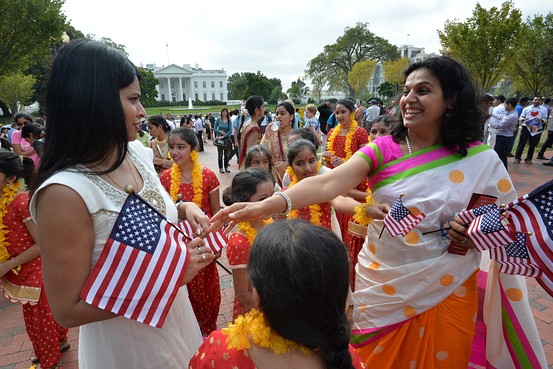Khadi Couture
There’s been a lot of talk in the sari-wearing world lately about Booker-prize-winning Indian author Kiran Desai’s lament that she has given up wearing Indian clothes in the United States. In an interview with Heidi Julavits, the co-editor of a new book called “Women in Clothes”, Ms. Desai talks about wearing Western outfits in India, and vice versa, and says that garments from one place never look quite right in the other.
For her, the problem is that although she’d like to wear saris in America, she feels that taking care of them is impossible without the army of servants that she might have in India.
There are parts of what Ms. Desai says with which many South Asian women living in the West will sympathize.
As I’ve tried to find my own Indo-Western style, I have realized that certain pieces are unacceptable in certain places.
For example, when I’m in Delhi I’m almost always in a sari or in a cotton Patiala salwar, pants that have many more layers of fabric than a regular pair of salwar pants.
The fabric is stitched into pleats at the top of the pants so that the layers form a drape. Often, the pants are made out of bright, printed fabrics that look stunning against the blazing Delhi sun, and give just the right amount of breathability for the debilitating Indian summers.
But in the States, my Patiala salwars look like clown pants. I can’t wear them to meet with colleagues or even friends and expect to be taken seriously: The colors jar against the grays and navies of Americans skies, buildings and office wear and the voluminous fabric looks frankly ridiculous next to neat pencil skirts and slim-line capri pants.
However, unlike Ms. Desai, I haven’t given up on Indian clothes in America altogether.
It has taken many years of trial and error, and there have been moments when I’ve felt the shame of showing up to a formal event wearing something that in another context would be just right, but right there, looks like a costume. As I enter my thirties though, and as America enters a moment where more South Asians are protagonists in contemporary literature and stars of modern movies and TV shows, I think it is possible to blend Indian and Western styles without looking like you wish you were still on your spring break in Goa. Heck, J Crew even has a range of Nehru-collared shirts at the moment, so it must be possible. As I write, it is the intersession between Dusshera and Diwali, that most festive time of the Indian-Hindu calendar when the skies are ablaze with light and women’s formal saris and men’s silk sherwanis (suit with a high-necked, long jacket) come out from the backs of their closets. And even though I’m not in India to celebrate this year, when I do go to my local Diwali gathering here in the States, it just won’t feel quite right if I’m not in a sari. In light of that, these are my rules for wearing South Asian outfits in the West: First, I adjust my attitude. If I’m going to a formal event in America in a sari or a salwar kameez (loose pants and long tunic), then I prepare myself for the kinds of questions I might be asked about my outfit. Before I leave the house, I answer the most important question: Why am I wearing this particular garment to this occasion? Usually, the answer lies in what I’m trying to project through my clothing. If I’m wearing an ornate kanjivaram sari to a friend’s wedding, then I’m signaling to my friend that this happy day for her is also something I’m marking as a special occasion. Then, I make certain choices about the fabrics I wear. I’ve found that sticking to silk or polyester saris (unlike cotton that continually has to be washed and starched) seems to work. Those fabrics suit a colder climate, as do shawls.
Shawls are one of my favorite accessories for cold weather wherever I am. Shawls and stoles from South Asia can be so incredibly ornate that they immediately dress up even the dullest pant-top combo. For more somber occasions, I choose Kashmiri Pashminas, with delicate embroidery work on pure woven fabric. If I want to go a little funkier, I choose Gujarati mirror-laden shawls or chunky, triangular embroidery against bright-colored wool shawls from Rajasthan. Finally, though I may forsake my Patiala salwars, I never give up on kurtas and kurtis (longish, flowing tops), worn with black pants or dark jeans. These come to my aid whether I’m at work, heading to a meeting, or going out with friends. The tunic with a skinny pant is the works-in-the-West take on a kurta and churidar (long, slim pants that gather in bunches at the ankles), and fail safe when you want to add an Indian accent to your look wherever you are. Piyali Bhattacharya divides her time between New Haven, Connecticut and New Delhi, India. She writes a blog called The Sari-torialist and is working on her first novel.













